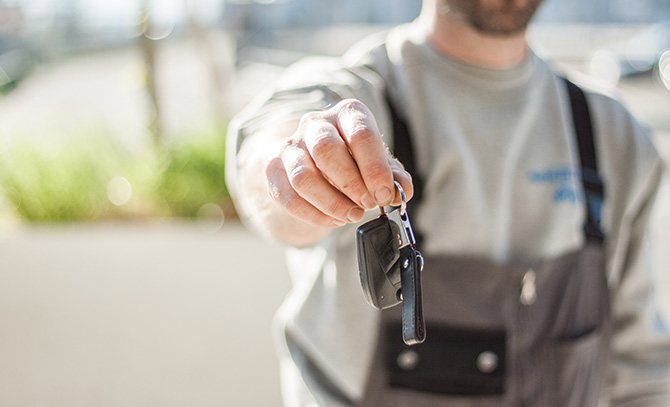
Nationwide Vehicle Contracts shares its top tips to save you money by avoiding charges at the end of your lease
At the end of your contract, depending on the type of contract that you took out, you may be returning your leased vehicle to the finance company - and before you do, the vehicle will be inspected for damage.
On the day of collection, a qualified inspector will complete a full visual inspection of the vehicle and will assess its condition, making note of any damages that fall outside of the Fair Wear and Tear policy. If there are any, you will be responsible for charges to repair them.
Obviously, you will not want this to happen, so here are some tips on what the inspector will be looking for, and how to avoid these charges.
Common Damage
Some of the most common damage problems that result in customers having to pay lease-end penalty charges include:
- Damage to wheels and trims* (including that caused by 'kerbing') All tyres, including the spare, must be legal with more than 1.6mm of tread
- Chips or dents on the bodywork*
- Scuffs, scratches, and scrapes to the paintwork*
- Rips, burns, or holes in the vehicle’s seats
- Damaged or stained interior
- Windscreen chips (although light scratching on the windscreen is acceptable provided it does not interfere with the driver’s line of sight)
- Missing documentation or equipment (such as keys)
- Missing or late Servicing or MOT
- Damage to Van Loading area of an unacceptable nature
- Damage from van graphics and decals (that need removing before returning the vehicle)
- Damage to any van roofing fittings (that also need removing before returning the vehicle)
*This includes scratches over 25mm (in relation to the vehicle’s age and mileage) and scratches under 25mm (where the primer and bare metal is showing).
These are damages that fall outside of those caused by an accident (which is covered by insurance) but can fall into the bracket of negligence and poor treatment, as well as those deemed to be Fair Wear and Tear (i.e. damage that occurs to a car or van as a result of normal use throughout the period of its lease.) You will be liable to pay for any excess damage that is found outside of fair wear and tear, in the form of lease-end penalty charges.
Excess Mileage
More charges that may occur at the end of a contract when the vehicle is returned may come as a result of the car having been driven for more than the contracted mileage. This is known as an Excess Mileage charge and is based on the number of additional miles that you have done over the agreed annual mileage allowance that you signed for and are contracted for.
You can find out more on excess mileage charges here but especially take note that mileage is solely the responsibility of the driver and not the leasing company or leasing broker. (i.e. it's up to you to keep within your agreed mileage.)
Service and Maintenance
So, as you can see from the above two sections, it is not just about checking your vehicle for damage just before you return it.
Yes; you should do a thorough check about 10-12 weeks before the end of the contract and return date. This will give you time to repair/correct any damages and replace any documentation if you are able to so you can avoid end-of-lease charges. (You can find advice on what exactly we suggest to do here)
But the whole maintenance should start from Day One of your lease, and continue throughout the leasing period.
- At regular intervals, perhaps once a month, inspect the outside of the vehicle, looking for dents and noticeable scratches (up to and over 25mm in length), and the depth of them (if there are any). Check all glass for cracks or chips, and check wheels for any damage to the wheel itself or the trim.
- Keep the interior clean and tidy, with a good valet at regular intervals, checking for stains, rips, and any other damage, including scratches to the trim. Avoid eating in the vehicle, and try and stop others doing it too (easier said than done!), but if food is consumed or drinks drunk, make sure that any litter is cleared away and any stains cleaned at the earliest opportunity.
- Regular cleaning of both the interior and exterior will also help to ensure the vehicle looks good. Polishing the vehicle exterior around four times a year will help reduce the effects of any stone-chip damage, limit the effects of air-borne contamination such as bird droppings and snow slush, remove traffic grime and make routine washing easier.
- Keep your documentation safe, and if any equipment malfunctions, contact the lease company at the earliest opportunity to avoid you being responsible for it.
- Keep up to date with all services and any MOTs that are required as agreed in the leasing contract.
One way to help you keep on top of everything is to enter into a Maintenance Contract with Nationwide Vehicle Contracts. For a fixed monthly fee, a maintenance contract includes all routine servicing, replacement tyres, MOT tests and other repair costs that might be required during the term of the contract. This cover is in addition to the standard UK manufacturer’s warranty and the 12 months roadside assistance offered with new vehicles, and more information can be found here.
Repairing Damage
If, when you do your own checks, you do encounter or discover any damage that you believe is likely to incur a penalty charge when it comes to the inspector's inspection, you can arrange to correct the damage before the vehicle is returned.
Before having any maintenance work carried out, it is important that you speak to your finance provider first to determine whether its approval is required. Usually, all repair work must be completed to a professional standard by repairers who provide a full warranty on their work.
For small areas of damage such as chips, dents and scratches, a SMART (small and medium area repair technique) repair may be appropriate provided your finance provider gives approval. It is advised that you use a SMART repair organisation to carry out the repair work. SMART repairers are members of the Vehicle Builders and Repairers Association (VBRA) and are obliged to comply with an OFT-approved Code of Practice which sets high standards for repairs and customer service.
For any larger repairs, again contact your finance provider to discuss your options.
(Although, as stated in the Service and Maintenance Section above, a Maintenance Contract could be a bit of a help.)
Preparing Documentation
On the day of collection, all documentation must be given back to the finance provider along with the vehicle, as well as some other pieces of equipment. This includes:
- All documentation such as the owner’s manual, Vehicle V5 document etc.
- The vehicle service book, fully date-stamped by an authorised repairer
- For service records that are held electronically, a printed copy of the maintenance/service record must be supplied
- For vehicles older than three years, a valid MOT certificate
- A full set of keys, including master and spares
- Any radio and security code cards
- All original wheel caps and locking wheel nuts
All personal belongings should be removed, including a private registration plate - also known as a cherished plate - if it is applicable. It is your responsibility to have it put onto retention prior to the vehicle collection, but be aware that this process may take up to 6 weeks.
With vans, any signage, graphics, decals or roof fittings must also be removed, and any damage from their use repaired.
MOT
Vehicles older than 3 years need to have an MOT completed prior to return.
If you are on a lease that exceeds 3 years, then you will need to arrange for an MOT test. It is preferable for an authorised dealer to perform this task, so contact your finance provider to discuss your options.
Damage Estimates
Any damage deemed outside of fair wear and tear will be noted on a condition report, along with the cost of repairing the damage or replacing any missing items. The inspector will ask you to sign the condition report once they have completed their review.
If you do not agree with the inspector's report, you will need to note the detail of your disagreement on the document provided. This will not remove or reduce the cost of the damage but will prompt a review process by the finance provider. Here, a damage team will look to see if the damage in the imagery provided matches the recharge cost quoted and whether the charges will stand. If not, the costs may be removed.
Some estimated examples of damage repair costs are below (although they can be higher depending on the extent of damage):
- Repair of excessive chips - from £150
- Repairing small dent - from £217
- Repairing small deep scratch - from £150
- Repairing bumper dent - from £178
- Wheel scuff repair - from £67
- Tyre replacement - £111+
Disputing End-of-Lease Charges
If you are unhappy with any of the end-of-lease charges issued by the finance provider, you will need to contact them direct to give them the opportunity to resolve the matter. It is advised that you contact them in writing, explaining the issue and how you would like them put things right. You can find the contact details for your relevant finance provider by logging into your online Customer Account.
If the issue remains unresolved and the final response from the finance provider is deemed unsatisfactory, the driver can escalate a complaint to the BVRLA Alternative Dispute Resolution (ADR) service as long as the finance provider is a BVRLA member.
The ADR service can be contacted via the BVRLA website. Alternatively, a complaint can be submitted by post to:
Dispute Resolution Team
British Vehicle Rental & Leasing Association
River Lodge
Badminton Court
Amersham
HP7 0DD
The BVRLA dispute resolution team will investigate your complaint and will respond within five working days in keeping with their Code of Conduct. A decision and explanation of findings will be supplied in writing within 30 days of receipt.
Overall we suggest that you treat your vehicle as if it is your own pride and joy - looking after it as if it were a show vehicle. Admittedly, that is not always possible, especially in a work environment, but to save yourself time, heartache and money at the end of the leasing period when inspection time is due and you have to say farewell to it, the upkeep of your vehicle should be a priority.
Originally posted: 7th May 2019

